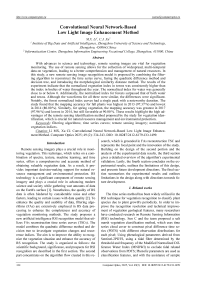Convolutional Neural Network-Based Low Light Image Enhancement Method
Автор: Li M.X., Xu C.J.
Журнал: Компьютерная оптика @computer-optics
Рубрика: Численные методы и анализ данных
Статья в выпуске: 2 т.49, 2025 года.
Бесплатный доступ
With advances in science and technology, remote sensing images are vital for vegetation monitoring. The use of remote sensing allows for the collection of widespread, multi-temporal data on vegetation, leading to a better comprehension and management of natural resources. In this study, a new remote sensing image recognition model is proposed by combining the filtering algorithm to reconstruct the time series curve, fusing the quadratic difference method and decision tree, and introducing the morphological similarity distance method. The results of the experiment indicate that the normalized vegetation index in towns was consistently higher than the index in bodies of water throughout the year. The normalized index for water was generally close to or below 0. Additionally, the normalized index for forests surpassed that of both water and towns. Although the waveforms for all three were similar, the differences were significant. Notably, the forest normalized index curves had a single peak with a noteworthy duration. The study found that the mapping accuracy for fall plants was highest in 2013 (97.37 %) and lowest in 2014 (80.00 %). Similarly, for spring vegetation, the mapping accuracy was greatest in 2017 (97.96 %) and lowest in 2014, but still favorable at 90.00 %. These results highlight the high advantages of the remote sensing identification method proposed by the study for vegetation identification, which is crucial for natural resource management and environmental protection.
Filtering algorithms, time series curves, remote sensing imagery, normalized vegetation indices
Короткий адрес: https://sciup.org/140310474
IDR: 140310474 | DOI: 10.18287/2412-6179-CO-1499


